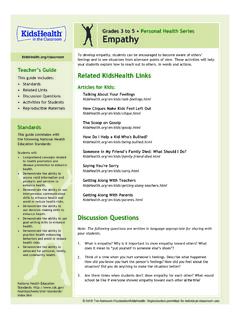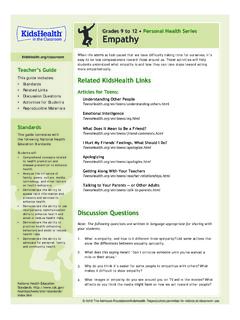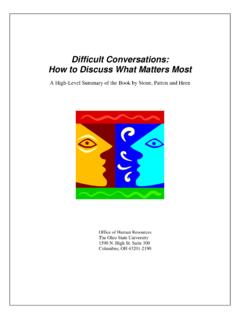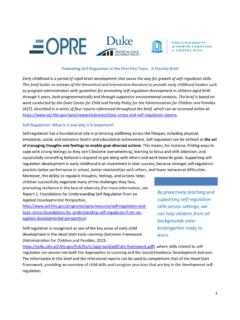Transcription of Men in Nursing: Their Influence in a Female Dominated …
1 10 Fall, 2014 Journal for Leadership and InstructionAbstractAn analysis performed by Staiger, Auerback, andBuerhaus (2012) on the RN workforce model suggests thatbetween 2010 and 2015 there will be a decrease in the RN'semployment as the economy improves and the baby boomerpopulation retires. This article centers on the road blocksmen face in nursing education, clinical experiences, job pref-erences in a Female Dominated career, and how nursingschools can address barriers to men in the last decade it was predicated that therewould be a massive nursing shortage due to the high per-centage of baby boomers that would retire. This nursingshortage was somewhat alleviated because of the 2008recession when many of these baby boomers did not retireand leave the nursing 2014, the job prospective for new graduatenurses continues to be grim, and this may imply that it isnot necessary to continue to increase the number of newnurses.
2 The American College of nursing suggests thatthis strategy does not take into consideration factors suchas: the Bureau of Labor Statistics' Employment Projections2012-2022 that the total number of nursing job openingswould be million by 2022, (American Association ofColleges of nursing ). In addition, an analysis performedby Staiger, Auerback, and Buerhaus (2012) on the RNworkforce model suggests that between 2010 and 2015there will be an increase in the RN's employment as theeconomy improves and the baby boomer population re-tires. It is inevitable that the "demand for health care isexpected to increase, as an estimated 32 million additionalAmericans obtain health insurance coverage" (Staiger,Auerback, and Buerhaus, 2012, p. 1465).In response to the anticipated nursing shortage,men can fill the void of the potential nursing shortage. Mencontinue to be a minority in the nursing profession althoughsmall increases in Their representation have occurred in thelast seven years.
3 The Census (2006) report indicated thatmen only constituted 7% of the United States workforce innursing. National Council of State Boards of nursing foundMen in nursing : Their Influence ina Female Dominated CareerBy Susan Barrett-Landau, , MS, ANP/FNP, RN-BC;and Sharon Henle, , MS, ANP, RHIA, CNE, RNthat men account for 7% of the RN workforce. A survey con-ducted by the Census Bureau in February 2013 foundthat men now comprise of all RNs (Census Bureau'sIndustry and Occupation Statistics, 2013). Recruiting menwould be a viable way to increase the number of registerednurses and to promote a more diverse population of nursesin the recently, many occupations were traditionallyclassified according to gender. People held a set of expecta-tions concerning whether or not specific employment posi-tions required masculine or feminine qualities to fulfill perceptions have changed considerably in the recentpast, especially as they relate to the role of females in Ameri-can society.
4 More and more women are now found in formerlymale- Dominated employment positions, such as trades andprofessions. However, little change in gender representationhas occurred as it relates to Female - Dominated employment,and no field better exemplifies the situation than that found inthe field of nursing (Meadus & Twomey, 2011). According tothe Census Bureau's Industry and Occupation Statistics(2013), men represented 9% of registered nurses and at thattime men's average salary was $60,700 as opposed to womenwho earned $51,100 per , 2014 Journal for Leadership and InstructionFamily InvolvementMcLaughlin, Moutray, & Moore (2010), found thatentry into nursing for men is often pre-dated by familial in-volvement in professional nursing , where moral support,often critical in Their decision making, is often found. Un-less Their role identity is supported by a significant other orgroup in Their social environment, men do not choose nurs-ing as a nursing career choice (Cook-Krieg, 2011).
5 Difficultyin conforming to role expectations among potential malenurses may be alleviated by the support of friends and rela-tives. Acquaintances and family relations generally havemixed feelings while most fathers are opposed to Their sonsbecoming a registered nurse (Pham, 2011).History of NursingThrough the efforts of Florence Nightingale in themid-nineteenth century, nursing was established as awomen's profession (Hus, Chen & Lou, 2010).Nightingale's image of the nurse as subordinate, nurturing,domestic, humble, and self-sacrificing, as well as not tooeducated, became prevalent in society. The American Nurs-ing Association ostracized men from nursing until 1930,when as a "result of a bylaw amendment, provision wasmade for male nurses to become members of the Ameri-can Nurses' Association" (In Review - American Nurses'Association, p. 6). Looking back in nursing history, FlorenceNightingale, and the American nursing Association ostra-cized men from the nursing wasn't until 1894 when Female nursesstarted to organize and Female nursingschools were created in New York and theAmerican nursing Association (ANA) wasformed.
6 The ANA excluded men until 1930and in essence had the goal of keeping menout of military nursing . At this point in historymilitary nursing had been a predominantlymale job, had turned into an exclusively fe-male position and would continue on to be-come the most stereotyped Female domi-nant job. It wasn't until after the Korean Warwhen males were finally accepted back intothe field of nursing (Gender Equality in a Fe-male Dominated Work Field, 2010, ).Prior to the organization of Female nursing schoolsand as early as the fourth and fifth centuries, men providednursing care to members of various religious orders (Cook-Krieg, 2011, p. 22-23), and held the predominant role inorganized nursing in western society. In 2013, a growingnumber of men are entering the nursing profession, forreasons, as they see it, of economic opportunity, despitethe fact of an ever-changing health care system that con-tinues to redefine the role of the nurse.
7 The AmericanNurses' Association (2013), and the National League forNursing have both spoken in support of males in nursing (National League for nursing , 2008).To encourage men to enter the nursing professionand, "if nursing is to survive in the 21st century, Nightingaleimage must be counterbalanced by an entry and acceptanceof a larger number of men into the profession" (Meadus,2000, p. 11).Professional AcceptanceHowever, men are having problems in achievingprofessional acceptance in Their nursing role both by so-ciety in general and by Their colleagues in particular. Manymale and Female patients have negative attitudes regard-ing male nurses and often request that a Female be sub-stituted. Discrimination exists among many Female nursestoward Their male colleagues, regarding them as homo-sexuals, and therefore, not acceptable as equals with theconsequent loss to the men of a sense of camaraderienecessary for a feeling of fulfillment in one's work (Brown,2009).
8 Even healthcare administrators have been forcedto defend policies that discriminate between male andfemale male nurses are a minority in the nursingworkforce, it has been reported that "male nurses made upto 23% referrals to the Investigating Panel of the NMC (Nurs-ing & Midwifery Council in 2009/10, with 42% being removedfrom the register (Prideaux, 2010).Thus, men are having to seek legal recourse todefend Their right to equal employment in the nursing pro-fession. However, while on the one hand men are taking aproactive role in forcing changes, others seek to circumventthe problem by the pursuit of specialties that are acceptablymale, such as in anesthesia and psychiatric nursing . Literature ReviewResearch has shown that men play an importantrole in establishing nursing as a more respected careeroption. With the integration of men into the nursing pro-fession, Female nurses benefit by means of pay equityand a greater economic position for women (Cottingham,2014).)
9 Even though there are less men in nursing , litera-ture denotes men earn higher salaries, along with poten-tial career advancement within multiple career pathwaysthat lure men to the nursing positions (Brown 2009).Bagihole and Cross (2006) interviewed 10 British menwho were employed in Female Dominated jobs. The studyfound that men believed they "should be role models forpromoting the profession" (p. 42).Physical strength places male nurses at an ad-vantage for certain positions or opportunities in the healthcare settings, such as, psychiatric care, and are hired in psychiatric areas because of Their physi-cal strength to ensure safety of the personnel and patient,and in orthopedics where there is a need for heavy equip-ment to be moved and assembled (Cook-Krieg, 2011,Goriup & Pajnkihar, 2014).12 Fall, 2014 Journal for Leadership and InstructionSocial ConceptsOne of the main reasons for the shortage of men isthe societal stereotype that portrays nursing as a femaleprofession (Cook-Krieg, 2011).
10 Prior to Nightingale's reformwhich was instrumental in creating nursing as a predomi-nately Female occupation, men had a historical role in nurs-ing. Cook-Krieg, (2011), goes on to say:When asked about the public's perceptionof male nurses, the Female students indi-cated that they perceived the public's viewof nursing to be accepting of male nursesin general; however they felt that societysometimes considers male nurses as ho-mosexual or feminine. The male studentsfelt that the public's image of nursing waschanging and that they were more accept-ing of men, however, they were viewed asodd or special (p. 27).Cook-Krieg, (2011) identified the following barriersto nursing education for men: social isolation, refusal to ad-dress individual learning needs, and reluctance of othernurses to acknowledge men as a vital part of the nursingprofession. Brown, (2009) "They assert that nursing schoolsdo not address the differences in communication styles ofmen and women, and do not prepare them to work primarilywith women " (p.)














